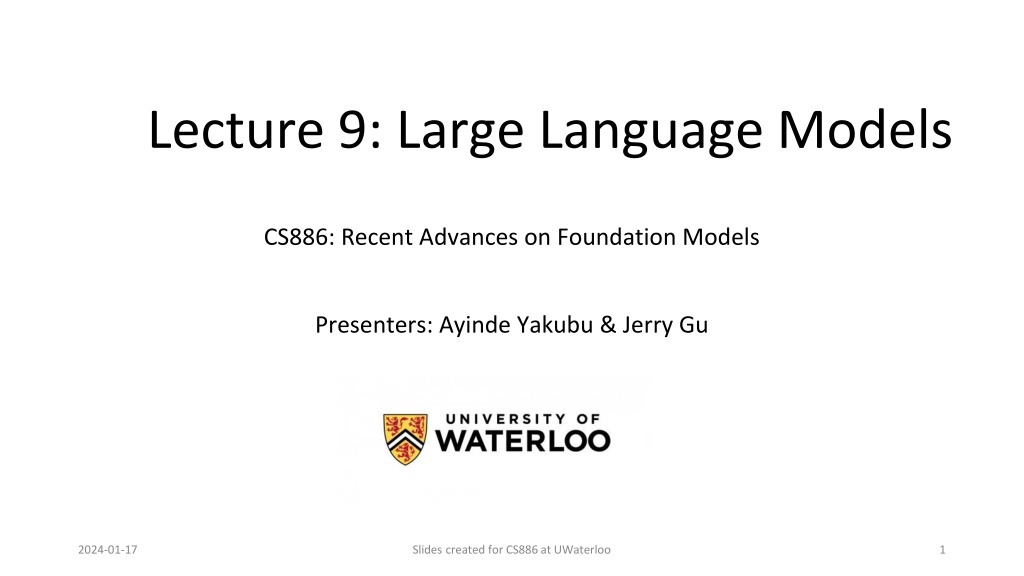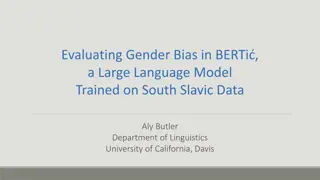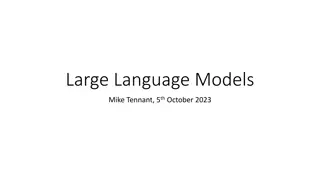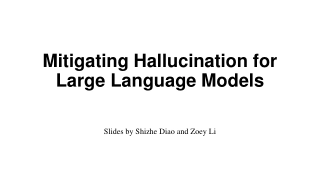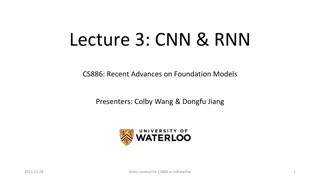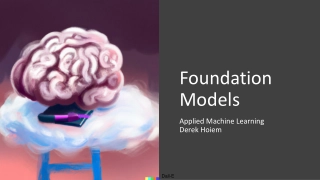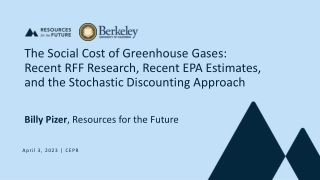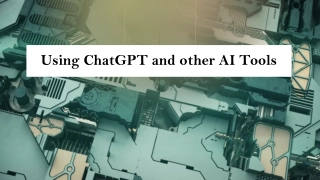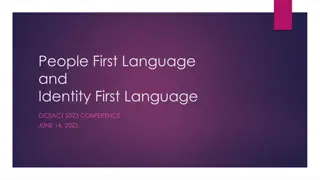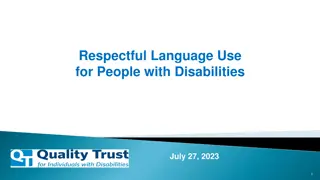Recent Advances in Large Language Models: A Comprehensive Overview
Large Language Models (LLMs) are sophisticated deep learning algorithms capable of understanding and generating human language. These models, trained on massive datasets, excel at various natural language processing tasks such as sentiment analysis, text classification, natural language inference, semantic understanding, reasoning, summarization, and question answering. The comparison between traditional machine learning and deep learning models highlights the significant advantages of LLMs in terms of performance, data size, complexity, and interpretability. The presentation also delves into the T5 framework, showcasing its unified approach to text-related tasks.
Download Presentation
Please find below an Image/Link to download the presentation.
The content on the website is provided AS IS for your information and personal use only. It may not be sold, licensed, or shared on other websites without obtaining consent from the author. Download presentation by click this link. If you encounter any issues during the download, it is possible that the publisher has removed the file from their server.
Presentation Transcript
Lecture 9: Large Language Models CS886: Recent Advances on Foundation Models Presenters: Ayinde Yakubu & Jerry Gu 2024-01-17 Slides created for CS886 at UWaterloo 1
Agenda Language Model T5 In-context Learning GPT-3 Codex Llama-2 Mixtral of Experts PaLM Q&A Session 2024-01-17 Slides created for CS886 at UWaterloo 2
What is Large Language Model (LLM)? Language models are computational models that have the capability to understand and generate human language. Deep learning algorithm that can perform various NLP tasks Are trained on massive datasets that allow them to recognise, translate, predict, or generate text or other content Unsupervised multi-task learners - - - - 1. Chang, Y., Wang, X., Wang, J., Wu, Y., Zhu, K., Chen, H., Yang, L., Yi, X., Wang, C., Wang, Y., Ye, W., Zhang, Y., Chang, Y., Yu, P.S., Yang, Q., & Xie, X. (2023). A Survey on Evaluation of Large Language Models. ArXiv, abs/2307.03109. Slides created for CS886 at UWaterloo
Large Language Model (LLM) Comparison Comparison Traditional ML Deep Learning LLMs Training Data Size Large Large Very Large Feature Engineering Manual Automatic Automatic Model Complexity Limited Complex Complex Interpretability Good Poor Poorer Performance Moderate High Highest Hardware Requirements Low High Very High Slides created for CS886 at UWaterloo
Natural Language Processing Tasks Natural Language Understanding Sentiment Analysis: This is a classification task. It analyzes and interprets text to determine their emotional inclination. The result is usually a binary (positive and negative) or triple (positive, neutral or negative) Text Classification: This is related to sentiment analysis though encompasses more. Natural language Inference (NLI): determination of whether a given hypothesis logically follows from a given premise . ChatGPT does very well on NLI tasks. Semantic Understanding:Interpretation and comprehension of words, phrases, sentences and the relationships between them. Reasoning Models must comprehend provided information and utilize reasoning and influence to deduce answers when explicit responses are absent. Natural Language Generation Summarization: ability to create a concise abstract for a given sentence or paragraph. Question answering: Creating answers to specific questions Slides created for CS886 at UWaterloo
T5 Framework Unified (text) approach to tasks Translate English to German: That is good Das is gut cola sentence: The course is jumping well. Not acceptable T5 Stsb (similarity score 1-5) Sentence 1: The rhino grazed on the grass, sentence 2: A rhino is grazing in a field 3.8 Summarize: state authorities dispatched emergency crews tuesday to survey the damage after an onslaught of severe weather in Mississippi Six people hospitalized after a storm in attala county 2. Raffel, C., Shazeer, N., Roberts, A., Lee, K., Narang, S., Matena, M., ... & Liu, P. J. (2020). Exploring the limits of transfer learning with a unified text-to-text transformer. The Journal of Machine Learning Research, 21(1), 5485-5551. Slides created for CS886 at UWaterloo
T5: Transformer Architecture Uses word2vec to generate numeric representation vector for each token in the input sequence Input Input Embedding Positional Encoding Decoding Component Decoder Encoding Component Decoder Encoder Decoder Encoder Encoder Linear Output Softmax Slides created for CS886 at UWaterloo
Transformer Architecture Decoding Component Encoding Component Decoder Self-Attention Encoder Self-Attention Encoder-Decoder Attention Feed-Forward Feed-Forward Decoder Encoder Linear Output Softmax Slides created for CS886 at UWaterloo
T5 Transformer Model Architecture Encoder/decoder blocks similar in sizes Each block comprises self-attention, optional encoder-attention, and a feed- forward network - - Slides created for CS886 at UWaterloo
T5 Transformer Attention Encoder-decoder attention Queries come from the previous decoder layer The memory keys and values come from the output of the encoder Allows every position in the decoder to attend to all positions in the input sequence Helps the model align words in the input sequence with the words in the output sequence Encoder contains self-attention All of the keys, values and queries come from the same place, the output of the previous layer in the encoder Each position in the encoder can attend to all positions in the previous layer of the encoder Masked self-attention in the decoder Allows each position in the decoder to attend to all positions in the decoder up to and including that position Prevents leftward information flow in the decoder via a scaled dot-product attention by masking out ( setting to - ) all values 3. A. Vaswani et al., Attention is All you Need, in Advances in Neural Information Processing Systems (NeurIPS), 2017. Slides created for CS886 at UWaterloo
T5 Architecture variants A major distinguishing factor is the mask used by different attention mechanisms in the mode Blocks represent elements of sequence, lines attention visibility Dark grey lines correspond to fully-visible masking and light grey lines correspond to causal masking Slides created for CS886 at UWaterloo
T5 Attention Mask Patterns Slides created for CS886 at UWaterloo
T5 Performance of architecture variants Architecture Objective Params Cost GLUE CNNDM SQuAD SGLUE EnDe EnFr EnRo *Encoder-decoder Denoising 2P M 83.28 19.24 80.88 71.36 26.98 39.82 27.65 Enc-dec, shared Denoising P M 82.81 18.78 80.63 70.73 26.72 39.03 27.46 Enc-dec, 6 layers Denoising P M/2 80.88 18.97 77.59 68.42 26.38 38.40 26.95 Language model Denoising P M 74.70 17.93 61.14 55.02 25.09 35.28 25.86 Prefix LM Denoising P M 81.82 18.61 78.94 68.11 26.43 37.98 27.39 Encoder-decoder LM 2P M 79.56 18.59 76.02 64.29 26.27 39.17 26.86 Enc-dec, shared LM P M 79.60 18.13 76.35 63.50 26.62 39.17 27.05 Enc-dec, 6 layers LM P M/2 78.67 18.26 75.32 64.06 26.13 38.42 26.89 Language model LM P M 73.78 17.54 53.81 56.51 25.23 34.31 25.38 Prefix LM LM P M 79.68 17.84 76.87 64.86 26.28 37.51 26.76 Slides created for CS886 at UWaterloo
T5 Input - Colossal Clean Crawled Corpus 20TB of text data extracted from web pages each month Needed to be cleaned up Heuristics for cleaning up - Remove boilerplate texts - Remove duplicates - Retained lines containing at least 5 words - - - Slides created for CS886 at UWaterloo
T5: Downstream Tasks Measure general language learning abilities Sentence acceptability judgement Sentiment analysis Paraphrasing/sentence similarity Natural language inference Coreference resolution Sentence completion Word sense disambiguation Question answering - - - - - - - - - Slides created for CS886 at UWaterloo
T5: Training the model All tasks are formulated as text-to-text tasks Pre-train each model for 2 = 524,288 steps Use a maximum sequence of 512 and a batch size of 128 sequences Pack multiple sequences into each of batch 2 or 65,536 tokens Pre-training batch size X number of steps 2 34B tokens 2 tokens only covers a fraction of the entire C4 data set Learning rate is inverse square root schedule: 1 / max(n,k) where n is the current training iteration and k is the number of warm-up steps (set to 10 ) Sets the learning rate of 0.01 for the first 10 steps, then exponentially decays the learning rate until pre-training is over. Learning rate of 0.001 when fine-tuning - - - - - - - - - Slides created for CS886 at UWaterloo
T5 - Unsupervised Objectives - Provides mechanism through which the model gains general-purpose knowledge to apply to downstream tasks Ingest a sequence of token IDs corresponding to a span of text from input unlabelled text data set - Original Text Thank you for inviting me to your party last week. Inputs Thank you <X> me to your party <Y> week. Targets <X> for inviting <Y> last <Z> Slides created for CS886 at UWaterloo
T5 - Pre-training Data set Corruption strategies Corruption rate Corrupted span length High-level approaches 10% 2 Mask Language Modelling 15% Replace spans 3 BERT-style 25% Drop 5 Deshuffling 50% 10 Slides created for CS886 at UWaterloo
T5 - Performance Results Data set *C4 Size 745GB GLUE 83.28 CNNDM 19.24 SQuAD 80.88 SGLUE 71.36 EnDe 26.98 EnFr 39.82 EnRo 27.65 C4, unfiltered 6.1TB 81.46 19.14 78.78 68.04 26.55 39.34 27.21 RealNews-like 35GB 83.83 19.23 80.39 72.38 26.75 39.90 27.48 WebText-like 17GB 84.03 19.31 81.42 71.40 26.80 39.74 27.59 Wikipedia 16GB 81.85 19.31 81.29 68.01 26.94 39.69 27.67 Wikipedia +TBC 20GB 83.65 19.28 82.08 73.24 26.77 39.63 27.57 Slides created for CS886 at UWaterloo
T5 - Pre-training Loss Slides created for CS886 at UWaterloo
T5 Scaling Increasing compute power results in better performance Baseline model has 220M parameters, is pre-trained and fine tuned for 2 and 2 steps respectively Increasing training time and/or model size Increasing baseline model size Undertake longer training to improve performance Scale up model sizes - - - - - - Slides created for CS886 at UWaterloo
Reflections on T5 -Text-to-text provides a simple way to train a single model on a wide variety of tasks using the same loss function and decoding procedure Successfully applied to abstractive summarization, classification tasks like natural language inference, and regression task like STS-B Comparable performance to task-specific architectures Architectures Original encoder-decoder form worked best Uses twice as many parameters as encoder-only (e.g. BERT) Unsupervised objectives: Denoising objectives train the model to reconstruct randomly corrupted text performs well Data sets - Used the (Colossal Clean Crawled Corpus) C4 data set Training strategies Updating all of pre-trained model s parameters Scaling Slides created for CS886 at UWaterloo
In-Context Learning Need for a large dataset for every task limits applicability of language models - its not practical Potential to exploit spurious correlations in training data grows with the expressiveness of the model and narrowness of the training distribution Language models are few-shot learners Humans do not require large supervised datasets to learn most language tasks - a brief directive is sufficient Meta-learning or zero-shot transfer allows the model to develop a broad set of skills and pattern recognition abilities at training time Not as performant as reinforcement learning from human feedback (RLHF) Slides created for CS886 at UWaterloo
Language model meta-learning Language model develops a broad set of skills and pattern recognition abilities during training Slides created for CS886 at UWaterloo 4. Brown, T., Mann, B., Ryder, N., Subbiah, M., Kaplan, J. D., Dhariwal, P., ... & Amodei, D. (2020). Language models are few-shot learners. Advances in neural information processing systems, 33, 1877- 1901.
Language model meta-learning Task: Remove random symbols from a word Larger models make increasingly efficient use of in-context info Params: weights + biases Eval: GPT-3 Slides created for CS886 at UWaterloo
GPT-3 Architecture Slides created for CS886 at UWaterloo
GPT-3 Training Approaches Slides created for CS886 at UWaterloo
GPT-3 - Training dataset Based on raw Common Crawl dataset of up to 1T words Cleaned up original datasets by: Filtered Common Crawl based on similarity to a range of high-quality reference corpora Performed fuzzy deduplication at the document level Added known high-quality reference corpora to the training mix Used final cleaned up data in training Slides created for CS886 at UWaterloo
GPT-3 - Training dataset - Sizes, architectures, and learning hyper-parameters (batch size in tokens and learning rate) of the models trained All models were trained for a total of 300 billion tokens - Model Name GPT-3 Small GPT-3 Medium GPT-3 Large GPT-3 XL GPT-3 2.7B GPT-3 6.7B GPT-3 13B GPT-3 175B or GPT-3 nparams 125M 350M 760M 1.3GB 2.7GB 6.7GB 13.0B 175.0B nlayers 12 24 24 24 32 32 40 96 dmodel 768 1024 1536 2048 2560 4096 5144 12288 nheads 12 16 16 24 32 32 40 96 dhead 64 64 196 128 80 128 128 128 BatchSize Learning Rate 0.5M 6.0 x 10-4 0.5M 3.0 x 10-4 0.5M 2.5 x 10-4 1M 2.0 x 10-4 1M 1.6 x 10-4 2M 1.2 x 10-4 2M 1.0 x 10-4 3.2M 0.6 x 10-4 Slides created for CS886 at UWaterloo
GPT-3 Compute Consumption Slides created for CS886 at UWaterloo
GPT-3 Limitations Limitations in text synthesis Structural and algorithmic limitations Poor sample efficiency during pre-training Lack of interpretability Can perpetuate and amplify existing biases and unfairness in society Multilingualism - majority language model researches are done in English Slides created for CS886 at UWaterloo
CodeX introduction Recently, there has been progress in generating programs from language models Surprisingly, GPT3 could generate programs, even though it was never explicitly trained on code CodeX is a specialized GPT model trained on code - - - Slides created for CS886 at UWaterloo
CodeX evaluation While the performance of generative models are usually evaluated using match-based metrics by comparing output to a reference solution, there may be too many different possible output programs that are functionally equivalent to the reference solution for this metric to account for; indeed, it was found that one such metric called the BLEU score is unreliable An alternative method is to use functional correctness instead, which runs the output code on test cases to measure performance; it is preferable similar to how humans judge code - - Slides created for CS886 at UWaterloo
CodeX evaluation Can evaluate functional correctness using the pass@k metric, which calculates the fraction of problems such that at least one of k sample codes generated passed (all test cases) for that problem; pass@k = 1-(1- pass@1)k Can be interpreted as the result of evaluating the best of k samples Directly calculating the pass@k results in high variance; instead, n>=k sample codes are generated, the # of passed codes c is counted and the estimator 1-(n-cCk / nCk) is calculated for each problem and averaged That estimator is unbiased, unlike directly plugging in the empirical estimate of pass@1 into pass@k, which underestimates pass@k A set of 164 problems called HumanEval was created (each containing a function signature, docstring, body, and average of 7.7 unit tests), hand- written to avoid training on potential solutions - - - - - Slides created for CS886 at UWaterloo
CodeX training Fine-tuned GPT models up to 12B parameters on code Trained on 159GB dataset of unique Python files on GitHub Used the same learning rate as the corresponding GPT model, with a 175 step linear warmup and cosine learning rate decay. Trained on a total of 100 billion tokens, using the Adam optimizer with a weight decay coefficient of 0.1. - - - Slides created for CS886 at UWaterloo
CodeX results It was found that the cross-entropy test loss on a held-out validation set follows a power law of (N/5.92x107)-0.13, where N=# non-embedding params When only one sample can be evaluated, it was found that compared to randomly choosing a sample to evaluate, choosing the one with the highest mean log probability performs better, but with the highest sum log probability performs slightly worse. - -
CodeX comparison Model pass@1 pass@10 pass@100 GPT models and the largest free model from Tabnine were evaluated on HumanEval (with temperatures of 0.2, 0.4, or 0.8) GPT-Neo and GPT-J are models similar to CodeX, trained on The Pile dataset which has 8% GitHub code, and are the only GPT models with pass rates not close to 0 - GPT-NEO 125M 0.75% 1.88% 2.97% GPT-NEO 1.3B 4.79% 7.47% 16.30% GPT-NEO 2.7B 6.41% 11.27% 21.37% GPT-J 6B 11.62% 15.74% 27.74% - TABNINE 2.58% 4.35% 7.59% CODEX-12M 2.00% 3.62% 8.58% CODEX-25M 3.21% 7.1% 12.89% CODEX-42M 5.06% 8.8% 15.55% CODEX-85M 8.22% 12.81% 22.4% CODEX-300M 13.17% 20.37% 36.27% CODEX-679M 16.22% 25.7% 40.95% CODEX-2.5B 21.36% 35.42% 59.5% CODEX-12B 28.81% 46.81% 72.31% Slides created for CS886 at UWaterloo
CodeX-S There may be code unrelated to translating natural language to code, which may lower performance A set of training problems from relevant code was obtained from competitive programming websites and repositories with continuous integration CodeX-S is a version of CodeX with this supervised fine-tuning and it has improved performance - - - Slides created for CS886 at UWaterloo
CodeX-S results Prefers slightly higher sampling temperatures than CodeX, possibly due to a narrower distribution Outperforms CodeX by 6.5% on pass@1 and 15.1% on pass@100 - - Slides created for CS886 at UWaterloo
CodeX-D So far we have discussed how CodeX generates code from docstrings, but what about the other way around? CodeX-D is a version of CodeX that generates docstrings from code Each training problem contains the function signature, the reference solution, and docstring No way to measure functional correctness for docstrings - graded only 10 samples for each of 1640 problems by hand manually - pass@1 and pass@10 are 20.3% and 46.5% respectively (which is slightly lower than that for CodeX-S: 32.2% and 59.5% respectively) - - - - Slides created for CS886 at UWaterloo
CodeX Limitations Not sample efficient to train, as the training data totaled hundreds of millions of lines of code Performance decreases exponentially in docstring length Can make mistakes binding variables to operations, especially when there are a lot of them - - - Slides created for CS886 at UWaterloo
Llama-2 introduction -Family of pretrained and fine-tuned LLMs with billions of parameters -Can outperform other open-source LLMs and be on par with close- sourced LLMs Slides created for CS886 at UWaterloo Slides created for CS886 at UWaterloo
Llama-2 pretraining Most of the pretraining, architecture, and hyperparameters were adopted from Llama-1: - Standard transformer architecture - pre-normalization (normalized the input of each sub-layer instead of the output to improve training stability, like in GPT3) - SwiGLU activation function (allows more flexibility and expressiveness in the feed-forward layers to improve performance of transformer models compared to using standard activations like ReLU) - Instead of absolute positional embeddings, used rotary positional embeddings which use a rotation matrix which shows relative positions of tokens and allows the model to capture their dependencies; can improve performance because changing positions of words in a sentence can change its meaning. - Slides created for CS886 at UWaterloo
Llama-2 pretraining 7, 13, 34, and 70 billion parameters, with context length (i.e. amount of text that can be processed at a time) of 4k (doubled from Llama-1) Learning rate of 0.0003 for smaller models, 0.00015 for larger models with grouped query attention Trained using AdamW optimizer with a cosine learning rate schedule, on 2T tokens of data (40% more than Llama-1) - - - Slides created for CS886 at UWaterloo
Llama-2 pretraining evaluation Llama-1 and 2 base models, along with other open-sourced models MosaicML Pretrained Transformer (MPT) and Falcon, were evaluated on several benchmarks for comparison - For code, the average pass@1 score on HumanEval and MBPP is reported - For commonsense reasoning, world knowledge, reading comprehension, and math, the average of scores from 8, 2, 3, and 2 different methods is reported, respectively - Massive multitask language understanding (MMLU), Big Bench Hard (BBH), and Artificial General Intelligence evaluation (AGIEval) on English tasks are also reported. - Slides created for CS886 at UWaterloo
Llama-2 pre-training evaluation Size Code Commonsense Reasoning World Knowledge Reading Comprehension Math MMLU BBH AGI Eval 7B 30B 20.5 28.9 57.4 64.9 41.0 50.0 57.5 64.7 4.9 9.1 26.8 46.9 31.0 38.0 23.5 33.8 MPT 7B 40B 7B 13B 5.6 15.2 14.1 18.9 56.1 69.2 60.8 66.1 42.8 56.7 46.2 52.6 36.0 65.7 58.5 62.3 4.6 12.6 6.95 10.9 26.2 55.4 35.1 46.9 28.0 37.1 30.3 37.0 21.2 37.0 23.9 33.9 Falcon Llama-1 33B 65B 26.0 30.7 70.0 70.7 58.4 60.5 67.6 68.6 21.4 30.8 57.8 63.4 39.8 43.5 41.7 47.6 Llama-1 7B 13B 16.8 24.5 63.9 66.9 48.9 55.4 61.3 65.8 14.6 28.7 45.3 54.8 32.6 39.4 29.3 39.1 Llama-2 34B 70B 27.8 37.5 69.9 71.9 58.7 63.6 68.0 69.4 24.2 35.2 62.6 68.9 44.1 51.2 43.4 54.2 Llama-2 Slides created for CS886 at UWaterloo
Llama 2-Chat Llama 2-Chat is a version of Llama-2 with supervised fine-tuning through alignment techniques Supervised fine tuning with publicly available instruction fine- tuning data - it was found that using less (thousands instead of millions) but higher quality examples improved results Reinforcement learning with human feedback (RLHF) is applied after fine-tuning so the model can understand the user intentions to further align the model with human preferences - - - Slides created for CS886 at UWaterloo
Llama 2-Chat Human Preference Data Collection Data of human preferences obtained from human feedback For more diversity of collected prompts, binary comparison protocol was used to collect feedback - Annotators write prompts for the model, then for each prompt they choose one of 2 responses from different variants of the model (e.x. With different temperature) based on provided criteria (helpfulness or safety), and rank how much better their chosen response is on a scale of 4 points - Preference was given to helpfulness and safety - This data was received in batches over time (so the reward model improved over time) - - Slides created for CS886 at UWaterloo
Llama 2-Chat Reward Modeling Human preference data was used to train reward model (RM) so that patterns in the preferences can be learned, by changing internal text distribution of the base model The RM outputs a score based on prediction of the quality of the model (based on human preference) given a prompt and model response These scores were used as rewards for RLHF Initialized from pretrained model to avoid situations where the models would end up favouring hallucinations, with the same architecture and hyperparameters but with a regression head for outputting rewards 2 RMs: for helpfulness and for safety - - - - - Slides created for CS886 at UWaterloo
Llama 2-Chat Reward Modeling Used a binary ranking loss with a margin component: Lranking= log( (r (x, yc) r (x, yr) m(r))), where r is the reward model with model weights that takes (prompt, response) as input, ycis the chosen response and yris the rejected response - The margin component m(r) is a function of the preference rating (different for each reward model), which helps the RM give more distinct scores for more different responses The preference data was increased by combining with open- sourced ones Trained with same parameters as base model, but only ran 1 epoch (as it may overfit otherwise) and slightly lower learning rate - - - Slides created for CS886 at UWaterloo
